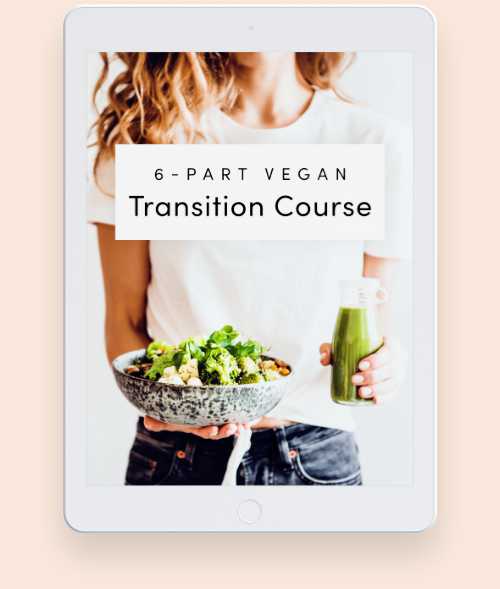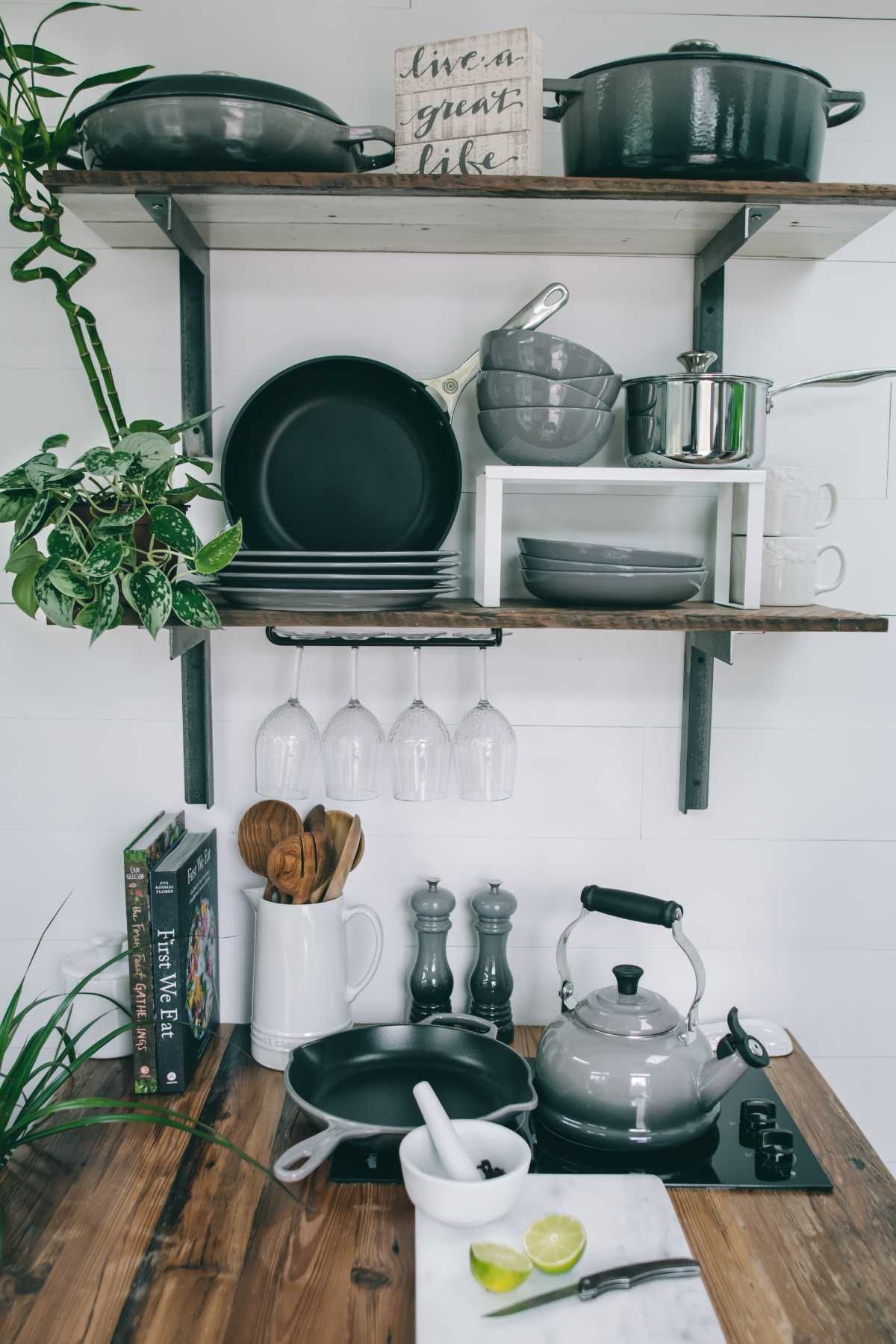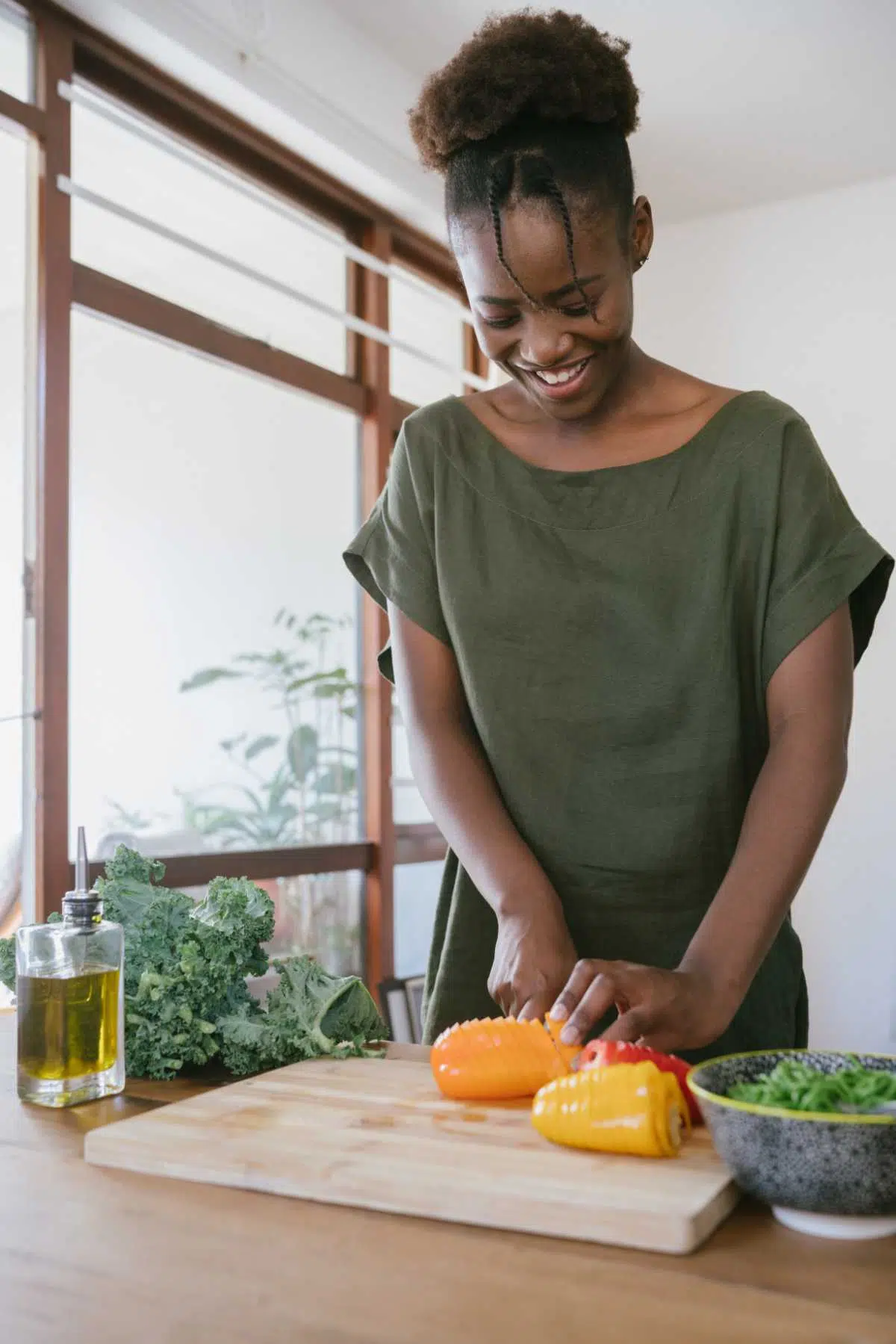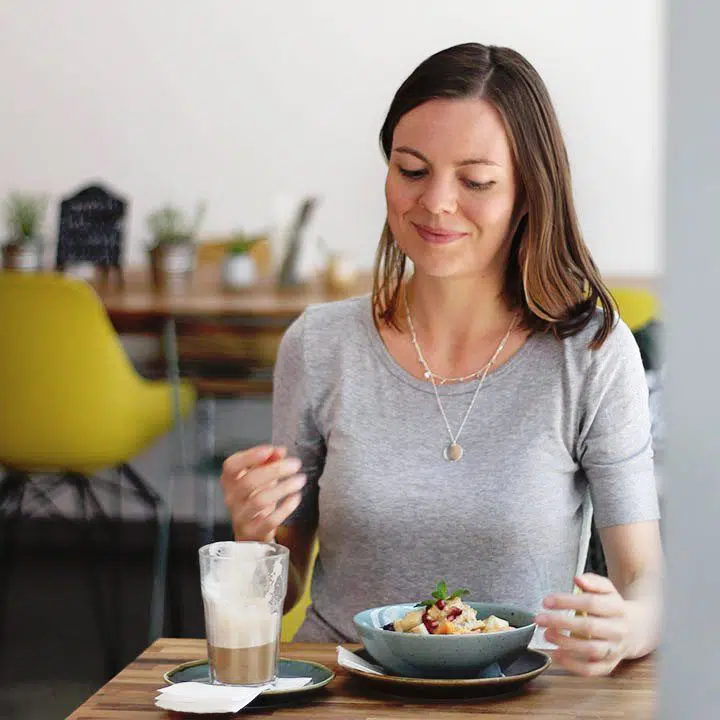Wondering how to cook vegan? Preparing plant-based dishes that taste fantastic is in no way harder than cooking with meat or cheese!
Even if you’re not a chef in the slightest, with some basic vegan cooking tips around your kitchen, pantry, ingredients, and more, you’ll be able to create delicious food in no time.

join our free vegan course!
Learn how to thrive on a plant-based diet with practical tips & a 3-day meal plan!
Whether you’re on a budget or so busy that you rely on meal delivery most days — there are many ways to make this lifestyle work.
Find more specific vegan cooking guides here:
- How to make vegan breakfast
- How to cook without oil
- How to make bliss balls
- How to spiralize veggies
Enjoy the following beginner tips, and check out our vegan transition guide for more help.
How to cook vegan
1. Stock your kitchen
If you want to learn how to cook vegan meals, you need to have a good selection of plant-based foods in your kitchen to begin with!
We suggest that you get at least a few items from each of the main vegan food groups:
- Grains
- Fruits
- Veggies
- Legumes
- Nuts & seeds
Don’t forget about fun foods, delicious condiments like ketchup, soy products, and staples like bread or pasta.
Check out our following articles for complete lists of what vegans eat, which staples to have at home, and how to figure out whether a product is vegan or not.
2. Find vegan alternatives
Replace animal-based components of your meals with plant-based substitutes! Don’t just leave out the meat or heavy cream and expect to have a satiating dish.
When it comes to texture, protein-rich ingredients like TVP, beans, or tofu are great for making meaty vegan recipes that taste delicious and help you eat enough plant-based protein!
Other simple swaps include soy milk instead of cow’s milk, maple syrup instead of honey, and olive oil instead of butter.
Check out our thorough guide on vegan alternatives and healthy food swaps!
3. Use the right kitchen tools
Let’s move to the next area in your kitchen. Get some basic cooking supplies to create a plethora of plant-based dishes! The most important ones include the following:
- Non-stick skillet or pan
- Saucepans (small and medium or large)
- 2-3 sharp knives
- Cutting board
- Silicone spatula
- Mixing bowls (small, medium and large)
- Wooden spoon
- Vegetable peeler
- Sieve
- Food containers (small, medium, large)
- Blender
If you want to make cooking and preparing meals more fun, we suggest you also look into getting any of the following tools.
- High-speed blender
- Food processor
- Steamer basket
- Pressure cooker
- Rice cooker
We personally use our Instant Pot every other day and highly recommend it if it fits your situation!
Full Kitchen Tools Guide →
4. Get into food prepping + planning
Usually, the biggest chore when it comes to cooking is preparing your components!
Washing and chopping vegetables, for example, can take up most of your prep time. So, do your future self a favor and wash and cut extra vegetables, which you can store in food containers in the fridge and use later!
We like to have most of our components for a recipe ready to go before we begin — there’s nothing worse than having to cut carrots once your stir-fry is already well underway! This will result in overcooked zucchini and undercooked carrots.
If you’d like to learn more about meal prepping or meal planning, check out our guides below.
5. Set up your kitchen
Before you start cooking or creating any meal, it’s crucial that you gather all or most ingredients you need and see if all of the equipment you need is clean and ready to use.
Preheat your oven or stove, read the whole recipe before starting, and ensure that your ingredients are washed and chopped.
Have measuring equipment at hand and see if you can “clean as you go” — meaning that you put away any ingredients you’ve already used for the recipe to see what still needs to go into the pot or bowl!
6. Learn basic cooking methods
These easy vegan cooking and preparation methods enable you to create lots of different meals:
- Blending — using a personal blender or immersion blender, you can make smoothies, sauces, soups, dips, or vegan ice cream.
- Processing — similar to blending but still different! Use a food processor to make falafel, bean patties, edible cookie dough, and other things where you want to preserve some texture instead of getting a mushy result.
- Steaming — using a steamer basket and a pot, this is a simple way to cook veggies while retaining most nutrients. Try it with broccoli, asparagus, green beans or sweet potatoes!
- Boiling — harder foods like potatoes, pasta, noodles or rice have to be boiled (cooked at high temperatures in water) until tender and ready to eat. We don’t use it for vegetables!
- Sautéing -— using a pan, cook water-rich vegetables or plant-based protein in oil or water until they create a nice golden exterior while stirring frequently with a spatula; since you’re using medium-high heat, your food cooks quickly and retains some crunch!
- Stir-frying — similar to sautéing, you stir-fry in a pan or wok but on even higher heat with a bit of oil or soy sauce; this method requires constant stirring and tossing of your veggies (broccoli, bell peppers, zucchini, carrots and asparagus are our favorites for this technique.)
- Roasting — this makes all veggies taste delicious! Place them in the oven at higher temperatures like 400°F+ until the natural sugars caramelize and the veggies smell fantastic! Try it with sweet potatoes or Brussels sprouts (recipe with a delicious marinade.)
- Grilling — get a nice char on your foods by cooking them on the grill! Try corn on the cob, tempeh, tofu, mushrooms, veggie burgers, or some of these 35+ BBQ recipes.

7. Follow easy vegan recipes
Especially if you haven’t made or eaten a lot of plant-based meals before, start with super easy and basic recipes!
Keep your dishes simple, use a few tried-and-true ingredients and straightforward cooking methods. Start with only light seasonings — you can always add more!
You can get some vegan cookbooks for beginners or check out the following collections:
8. Recreate old favorites
No need to eat smoothie bowls, quinoa salad, or other uncommon meals if you go vegan! Try to veganize your favorite meals first.
Whether you want to use store-bought replacements or make your own sauces and plant-based meats, you can still enjoy delicious foods, as the following examples show.
By the way, you can always search for “vegan xy” on Google and will find lots of ways to veganize a specific dish!
9. Add delicious flavor
One misconception about vegan food is that it tastes bland! That’s only true if you don’t know how to cook properly.
By adding delicious herbs, spices, and other condiments, you can flavor your veggies or beans the same way you would a piece of meat!
After all, nobody eats unseasoned steak or meatballs, right?
Try these flavorings for your food:
- Soy sauce — this adds not only salt but also savory umami flavor to your dishes.
- Mushrooms — when cooked down, they have a great texture plus earthy umami flavor!
- Garlic & onion — super common to infuse your dish with deep flavor.
- Nutritional yeast — you probably only know this food if you’re vegan! It adds a cheesy touch, enhances the flavor of savory dishes, and adds B vitamins.
- Adding fats — from olive oil to nut butter or avocado, fats bring out the flavor of food and offer a pleasant mouthfeel.
- Salt — makes bland food more palatable and brings out natural flavors; adjust to your preference!
- Vinegar or lemon juice — not just essential when making dressings, they can kick up any dish!
One more tip is to add salt or lemon juice to sweet recipes and something sweet to savory dishes to balance out the flavors.
10. Use sauces & condiments
This part deserves its extra mention! A good sauce brings any dish to the next level and is a great vehicle for veggies.
Create creamy gravy or white sauce by using thickeners like corn starch which you need to mix with cold water before heating it up to avoid lumps.
Cashews, almonds, peanuts, tofu, and soy yogurt are our favorite bases for making different kinds of sauces!
Let’s not forget about the humble hummus, too — it’s great for dipping, sandwiches, wraps, or to use as a dressing.
11. Make adjustments to recipes
We all have different taste preferences, so when a recipe calls for 1 teaspoon chili powder, you may want to start with just a pinch and work your way up from there.
Let me tell you, after years of being a food blogger: it is impossible to create a recipe that everyone will love!
That’s why you need to taste the food as you cook it.
This doesn’t just tell you whether something is salty or spicy enough but also how long or at which temperature it needs to be cooked for your desired texture!
If you see an ingredient listed that you either don’t have access to, are allergic to, or simply don’t like, it’s always possible to swap it for something similar!
Think white rice instead of brown rice or millet, gluten-free pasta instead of regular, zucchini instead of eggplant, or almond milk instead of soy milk.

12. Get creative
Our final recommendation is to not always follow recipes but instead use your favorite ingredients or components and freestyle with them!
Add a new ingredient here and there to your list and see if you like it — expanding your culinary horizon can be really exciting. Chances are you’ll find a new favorite food!
Check out these colorful vegan bowls recipes to see what’s possible with some creativity.
More vegan guides
Read these articles next for more tips and tricks around veganism.
Did you like our vegan cooking tips for beginners or would like to share one we missed? Let us know in the comments below and Pin this article here or send it to friends and family!


























 Alena Schowalter is a Certified Vegan Nutritionist who has been a vegetarian since childhood and vegan since 2012. Together with her husband, she founded nutriciously in 2015 and has been guiding thousands of people through different transition stages towards a healthy plant-based diet. She’s received training in the fields of nutrition, music therapy and social work. Alena enjoys discussions around vegan ethics, walks through nature and creating new recipes.
Alena Schowalter is a Certified Vegan Nutritionist who has been a vegetarian since childhood and vegan since 2012. Together with her husband, she founded nutriciously in 2015 and has been guiding thousands of people through different transition stages towards a healthy plant-based diet. She’s received training in the fields of nutrition, music therapy and social work. Alena enjoys discussions around vegan ethics, walks through nature and creating new recipes.
Are you new to plant-based eating? These vegan cooking tips for beginners help you create delicious meals in no time and set up your kitchen for success.